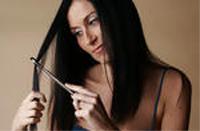
Another factor that has been linked to hair loss is the amount of sebum in the scalp. Sebum contains a high amount of DHT, and clogs pores in the scalp, both of which cause the malnutrition of the hair root. The amount of sebum in balding hair is related to the amount of oil in the hair. Meanwhile most doctors agree that frequent shampooing is advised in hair loss cases with oily scalps. The most important cause of hair loss is inadequate nutrition. Even a partial lack of almost any nutrient may cause hair to fall. But hair grows normally after a liberal intake of these vitamins. A high protein and and an iron rich diet is recommended for hair loss. An adequate intake of raw vegetables, fresh fruits, salads, green leafy vegetables should be included in the diet on a regular basis. There are many surgical procedures which will help to restore the hair from falling. Surgical restoration is the only permanent solution to baldness. It involves a series of operations that extract plugs of scalp from the sides and back of your head, where hair grows densely, and implant them on top and in front, where you are going bald. For men, hair loss is male pattern baldness. Yes, there are other types of hair loss, including rare conditions such as alopecia totalis and alopecia universalis, where the entire scalp and entire body, respectively, become completely bald due to a viral condition that is irreversible. There is also patch baldness, in which hair falls out in patches of the scalp. This is caused by stress or poor nutrition or adverse scalp conditions. But the hair will usually grow back once the cause has been rectified. The most familiar hair loss pattern is where the hair begins to recede in the hairline and the crown at roughly the same time. The hair in the mid-scalp or anterior scalp is often the last to go. But go it will, eventually leaving a man with the horseshoe of hair that is the telltale sign of typical male pattern baldness. The chief difference in womens androgenic hair loss from mens (both are hormone related) is that women tend to experience thinning that occurs in no particular pattern or part of the scalp. Unlike men, the scalp may not actually be totally denuded of hair, just thin to the point where the scalp is visible. Like men, however, the resulting hair loss is generally irreversible. Minoxidil (Rogaine). This over-the-counter medication is approved for the treatment of androgenetic alopecia and alopecia areata. Minoxidil is a liquid that you rub into your scalp twice daily to regrow hair and to prevent further loss. Some people experience some hair regrowth or a slower rate of hair loss or both. Minoxidil is available in a 2 percent solution and in a 5 percent solution. Finasteride (Propecia). This prescription medication to treat male-pattern baldness is taken daily in pill form. Many people taking finasteride experience a slowing of hair loss, and some may show some new hair growth. Positive results may take several months. Finasteride works by inhibiting the conversion of testosterone into dihydrotestosterone (DHT), a hormone that shrinks hair follicles and is an important factor in male hair loss. Rare side effects of finasteride include diminished sex drive and sexual function. As with minoxidil, the benefits of finasteride stop if you stop using it.
Many people (wrongly) will drop a handful of shampoo on their head and then rinse it off. Shampoo must be worked through all of your hair, as well as the scalp and hairline. Did you notice that when you shampoo your hair the amount of lather often varies? Usually, the more lather you have, the less buildup you have on your hair. It's also important to fully rinse out the shampoo to eliminate any residual detergents--they can damage the hair shaft and scalp. Excessive exposure to the sun can damage your hair by inducing oxidation of the sulfur molecules within the hair shaft, leaving the hair weak, brittle, dry and faded. People who bleach or lighten their natural hair color may also notice slight color changes in their hair when it is exposed to sun. Nutritionists advise healthy hair seekers to eat well-balanced diets that incorporate healthy proteins along with foods high in vitamins B, C, E, A and K. Hair instantly responds to the addition of protein-rich foods such as meats, eggs, cheese, seeds and nuts. Fish packs a double punch of protein combined with health building essential fatty acids and natural oils. We recommend you discuss your diet with a medical professional.
Hair is composed of Keratin, a special protein that also produces our fingernails and toenails the nails and forms the protective outer layer of our skin. Each strand of hair consists of three concentric layers, the cuticle, the cortex and the medulla. The innermost layer of hair is called the medulla and reflects light giving hair the various color tones it has. That's why hair color looks a lot different in sunlight than it does in the shade. Whether you have straight or curly hair depends on the shape of the cortex. If the cross section of the cortex is round you will have straight hair, if the cortex is oval shaped you will have curly or wavy hair.

Definition explainingAlopecia Areata
- Alopecia areata is a hair loss condition which usually affects the scalp. It can, however, sometimes affect other areas of the body.
Hair loss
- A progressive, diffuse loss of scalp hair in men that begins in the twenties or early thirties, depends on the presence of the androgenic hormone testosterone, and is caused by a combination of genetic and hormonal factors. Also called androgenetic alopecia.
Hair transplantation
- Hair transplantation is a surgical procedure used to treat baldness or hair loss (alopecia). Typically, tiny patches of scalp are removed from the back and sides of the head and implanted in the bald spots in the front and top of the head.
Protein
- Important building blocks of the body, composed of amino acids, involved in the formation of body structures and controlling the basic functions of the human body.
- Complex organic molecules made up of amino acids. Proteins are basic components of all living cells and are therefore among the principal substances that make up the body.
Ringworm
- The term "ringworm" refers to fungal infections that are on the surface of the skin. The early belief was that the infection was due to a worm, which it is not, although the name has stuck. Some of these fungi produce round spots, but many do not.
Thyroid
- A gland in the throat that produces hormones that regulate growth and metabolism.
- A large gland in the neck that functions in the endocrine system. The thyroid secretes hormones that regulate growth and metabolism.
Alopecia
- A hair loss, baldness, and epilation.
- Alopecia, also called hair loss, baldness, and epilation, is a common side effect of chemotherapy and radiation therapy.
Baldness
- A progressive, diffuse loss of scalp hair in men that begins in the twenties or early thirties, depends on the presence of the androgenic hormone testosterone, and is caused by a combination of genetic and hormonal factors. Also called androgenetic alopecia.
Biotin
Follicles
- A follicle (from the Latin folliculus) is a term to describe a small spherical group of cells containing a cavity.
Grafts
- To transplant or implant surgically into a bodily part to replace a damaged part or compensate for a defect.
Hormone
- A substance, usually a peptide or steroid, produced by one tissue and conveyed by the bloodstream to another to effect physiological activity, such as growth or metabolism.
Scalp
- The skin covering the top of the human head with its attached hair.
Stress
- Importance, significance, or emphasis placed on something.
- The relative force with which a sound or syllable is spoken.
- Accent or a mark representing such emphasis or force.
- An applied force or system of forces that tends to strain or deform a body.
- A mentally or emotionally disruptive or upsetting condition occurring in response to adverse external influences and capable of affecting physical health, usually characterized by increased heart rate, a rise in blood pressure, muscular tension, irritability, and depression.
- A state of extreme difficulty, pressure, or strain.
- A physical and psychological response that results from being exposed to a demand or pressure.
Testosterone
- A white crystalline steroid hormone, C19H28O2, produced primarily in the testes and responsible for the development and maintenance of male secondary sex characteristics. It is also produced synthetically for use in medical treatment.
|